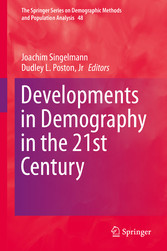
Developments in Demography in the 21st Century
von: Joachim Singelmann, Dudley L. Poston Jr
Springer-Verlag, 2020
ISBN: 9783030264925
Sprache: Englisch
330 Seiten, Download: 6241 KB
Format: PDF, auch als Online-Lesen
| Contents | 7 | ||
| Contributors | 9 | ||
| Part I: Introduction | 11 | ||
| Chapter 1: Developments in Demography | 12 | ||
| 1.1 Introduction | 12 | ||
| 1.2 Developments in Demography: Chapter Summaries | 14 | ||
| Chapter 2: What’s Changing the World? A Demographer’s Perspective | 19 | ||
| 2.1 Introduction | 19 | ||
| 2.2 The Rising Burden of Noncommunicable Diseases | 20 | ||
| 2.3 The Four Risk Factors that Account for Most NCDS | 23 | ||
| 2.4 Conclusion | 27 | ||
| References | 28 | ||
| Part II: Methodological and Statistical Issues | 30 | ||
| Chapter 3: A Demographic Evaluation of the Stability of American Community Survey (ACS) Estimates for ACS Test Sites: 2000 to 2011 | 31 | ||
| 3.1 Introduction | 31 | ||
| 3.2 Data and Methods | 32 | ||
| 3.3 Characteristics for Evaluation | 33 | ||
| 3.4 Geographic Areas | 33 | ||
| 3.5 Time Series of Census and ACS Estimates | 34 | ||
| 3.6 Results | 35 | ||
| 3.6.1 Bronx County, New York: Annual ACS Estimates | 36 | ||
| 3.6.2 Multnomah County, Oregon: 3-Year ACS Estimates | 36 | ||
| 3.6.3 Upson County, Georgia: 5-Year ACS Estimates | 38 | ||
| 3.6.4 Asian Population: Comparison of 5-Year ACS Estimates across Counties | 39 | ||
| 3.6.5 Signal from the Noise | 41 | ||
| 3.7 Conclusion | 43 | ||
| References | 45 | ||
| Chapter 4: Approaches for Addressing Missing Data in Statistical Analyses of Female and Male Adolescent Fertility | 46 | ||
| 4.1 Introduction | 46 | ||
| 4.2 Mechanisms: Why Are Data Missing | 47 | ||
| 4.3 Methods for Handling Missing Data | 48 | ||
| 4.3.1 Listwise Deletion | 48 | ||
| 4.3.2 Mean Substitution | 49 | ||
| 4.3.3 Mean Substitution for Subgroups | 49 | ||
| 4.3.4 Proxy Method | 49 | ||
| 4.3.5 Dropping the Variable(s) with Missing Data | 50 | ||
| 4.3.6 Multiple Imputation (MI) – Three Versions | 51 | ||
| 4.4 Data and Method | 52 | ||
| 4.5 Results | 53 | ||
| 4.6 Discussion | 62 | ||
| References | 65 | ||
| Chapter 5: Considering Local Measures of Poverty Using Shift-Share Techniques: A Comparative Analysis | 66 | ||
| 5.1 Introduction | 66 | ||
| 5.2 Shift-Share Analysis: Background | 67 | ||
| 5.3 Local Poverty Measures and Shift-Share Analysis | 68 | ||
| 5.4 Estimation Methodology & Data | 69 | ||
| 5.4.1 One-Way Fixed Effects Model | 69 | ||
| 5.4.2 Data | 70 | ||
| 5.5 Findings | 73 | ||
| 5.6 Conclusion | 74 | ||
| References | 75 | ||
| Part III: Data Issues | 76 | ||
| Chapter 6: Exploring Explanations for the High Net Undercount of Young Children in the 2010 U.S. Census | 77 | ||
| 6.1 Introduction | 77 | ||
| 6.2 The Undercount of Young Children | 78 | ||
| 6.3 Explanations for the High Net Undercount Rate of Young Children | 81 | ||
| 6.4 Summary | 93 | ||
| References | 94 | ||
| Chapter 7: Babies No Longer: Projecting the 100+ Population | 98 | ||
| 7.1 Introduction and Background | 98 | ||
| 7.2 Review of Past and Current Projections | 100 | ||
| 7.3 Alternate Research Projections | 102 | ||
| 7.3.1 Alternate Base Populations | 102 | ||
| 7.3.2 Alternate Survivorship Projections | 104 | ||
| 7.4 Summary and Conclusion | 105 | ||
| References | 106 | ||
| Chapter 8: Cohort Approaches Using Educational Data of the Czech Republic: Massification of Tertiary Education and Its Impact on Education Attainment | 107 | ||
| 8.1 Introduction | 107 | ||
| 8.2 Research Questions and Goals | 108 | ||
| 8.3 Theoretical Background | 109 | ||
| 8.3.1 The Second Demographic Transition | 109 | ||
| 8.3.2 Trow’s Conceptions of Elite, Mass and Universal Higher Education | 112 | ||
| 8.3.3 The Educational Attainment of the Population | 114 | ||
| 8.4 Development of the Czech Tertiary Educational System | 114 | ||
| 8.4.1 Indicators of Development of the Czech Tertiary System | 116 | ||
| 8.4.2 Cohort Entry Rate | 116 | ||
| 8.4.3 Net Entry Rate | 117 | ||
| 8.5 Educational Attainment Forecast | 120 | ||
| 8.6 Conclusion | 125 | ||
| References | 126 | ||
| Part IV: Issues of Health, Aging, and Mortality | 128 | ||
| Chapter 9: Factors Associated with Female Sterilization in Brazil | 129 | ||
| 9.1 Introduction | 129 | ||
| 9.2 Literature Review | 131 | ||
| 9.3 Data and Methods | 132 | ||
| 9.4 Results | 137 | ||
| 9.5 Discussion | 146 | ||
| References | 147 | ||
| Chapter 10: Aging and Family Support in the State of Mexico | 151 | ||
| 10.1 Introduction | 151 | ||
| 10.2 Background | 155 | ||
| 10.3 Data and Results | 157 | ||
| 10.4 Discussion | 159 | ||
| References | 161 | ||
| Chapter 11: Intimate Homicide Mortality in Alaska | 162 | ||
| 11.1 Introduction | 162 | ||
| 11.2 Data and Methods | 163 | ||
| 11.3 Demographic Features of the Subjects | 164 | ||
| 11.4 Three Theories of Intimate Homicide | 165 | ||
| 11.5 Results: Analyses of Twelve Cases in Alaska | 167 | ||
| 11.6 Discussion and Conclusion | 174 | ||
| References | 176 | ||
| Chapter 12: Cognitive Decline Among the Elderly: A Comparative Analysis of Mexicans in Mexico and in the United States | 177 | ||
| 12.1 Introduction | 177 | ||
| 12.2 Previous Research | 178 | ||
| 12.3 Data, Variables, and Methods | 180 | ||
| 12.3.1 Data | 180 | ||
| 12.3.2 Variables | 182 | ||
| 12.3.2.1 Dependent Variable | 182 | ||
| 12.3.2.2 Independent Variables | 182 | ||
| 12.3.2.3 Statistical Analyses | 183 | ||
| 12.4 Results | 183 | ||
| 12.4.1 Total HEPESE and MHAS Surveys | 183 | ||
| 12.5 Conclusions and Discussion | 190 | ||
| References | 190 | ||
| Part V: Issues in Social Demography | 193 | ||
| Chapter 13: The Urban Hierarchies of China and the United States | 194 | ||
| 13.1 Introduction | 194 | ||
| 13.2 Metropolitan and Urban Dominance | 196 | ||
| 13.3 Data and Methods | 198 | ||
| 13.4 Analysis and Findings | 203 | ||
| 13.5 Conclusion | 215 | ||
| References | 216 | ||
| Chapter 14: School District Formation as an Explanation for Spatial and Temporal Dimensions of Concentrated Poverty in Bexar County, Texas | 218 | ||
| 14.1 Introduction | 218 | ||
| 14.2 Neighborhood Poverty in Bexar County | 219 | ||
| 14.2.1 Historic Context | 219 | ||
| 14.2.2 Neighborhood and School Segregation as Reinforcing Mechanisms for Bexar County Poverty | 220 | ||
| 14.3 Explanations of Neighborhood Poverty: Review of Literature | 221 | ||
| 14.4 Data and Methods | 223 | ||
| 14.4.1 Independent Variables of Interest | 224 | ||
| 14.4.2 Analytic Strategy | 226 | ||
| 14.5 Results | 227 | ||
| 14.6 Discussion | 233 | ||
| 14.7 Policy Implications & Conclusions | 234 | ||
| References | 237 | ||
| Chapter 15: Union Formation Selectivity After Childbearing: Do Local Marriage Markets Matter? | 240 | ||
| 15.1 Introduction | 240 | ||
| 15.2 Marriage Selectivity | 242 | ||
| 15.3 Marital Search | 244 | ||
| 15.4 Research Aims and Expectations | 244 | ||
| 15.5 Data and Methods | 245 | ||
| 15.5.1 Sample Selection and Characteristics | 245 | ||
| 15.5.2 Dependent Variable | 248 | ||
| 15.5.3 Marriage Market Conditions | 249 | ||
| 15.5.4 Social Learning Characteristics | 249 | ||
| 15.5.5 Control Variables | 250 | ||
| 15.5.6 Partner/Wife Characteristics | 251 | ||
| 15.6 Analysis | 251 | ||
| 15.7 Results | 251 | ||
| 15.8 Discussion and Conclusion | 259 | ||
| Appendix | 261 | ||
| References | 263 | ||
| Chapter 16: Minority Student Participation in International Programs | 265 | ||
| 16.1 Introduction | 265 | ||
| 16.2 Review of Literature | 266 | ||
| 16.3 International Education at Historically Black Colleges and Universities (HBCUs) | 268 | ||
| 16.4 Methodology | 269 | ||
| 16.4.1 Population and Sample | 269 | ||
| 16.4.2 Survey Design | 270 | ||
| 16.5 Analysis | 270 | ||
| 16.5.1 Sociodemographic Characteristics of the Study Respondents | 271 | ||
| 16.5.2 General Attitudes and Abilities | 273 | ||
| 16.5.3 Foreign Language Proficiency and Ability | 276 | ||
| 16.5.4 Formal International Education and Travel Experiences | 277 | ||
| 16.5.5 Perceived Benefits After Traveling Outside the U.S. for Academic Purposes | 277 | ||
| 16.6 Conclusion | 277 | ||
| References | 280 | ||
| Chapter 17: Community Well-being and Mexican Interstate Migration in the United States | 284 | ||
| 17.1 Introduction | 284 | ||
| 17.2 Measurement of Mexican Interstate Migration | 285 | ||
| 17.3 A Gravity Model and an Ecological Model of Migration | 289 | ||
| 17.4 Data and Methods | 291 | ||
| 17.5 Results | 294 | ||
| 17.6 Discussion | 297 | ||
| References | 299 | ||
| Chapter 18: Family Values and Work in the Mississippi Delta: Effects of Marriage and Employment on the Well-being of TANF Participants | 301 | ||
| 18.1 Introduction | 301 | ||
| 18.2 Review of Literature | 302 | ||
| 18.2.1 Marriage | 302 | ||
| 18.2.2 Work | 303 | ||
| 18.2.3 Marriage, Employment, & Economic Wellbeing | 305 | ||
| 18.3 Data and Methods | 306 | ||
| 18.3.1 Data | 306 | ||
| 18.3.2 Estimation Methods | 309 | ||
| 18.3.3 Dependent Variables | 309 | ||
| 18.3.4 Independent Variables | 310 | ||
| 18.3.4.1 Employment and Marital Transitions | 310 | ||
| 18.3.4.2 Characteristics of the Spouse | 311 | ||
| 18.3.4.3 Characteristics of Work | 311 | ||
| 18.3.4.4 Location | 311 | ||
| 18.3.4.5 Controls | 311 | ||
| 18.4 Results | 312 | ||
| 18.4.1 Logistic Regression Models | 313 | ||
| 18.4.2 Simulations | 317 | ||
| 18.5 Summary and Conclusion | 321 | ||
| References | 322 | ||
| Index | 325 |








